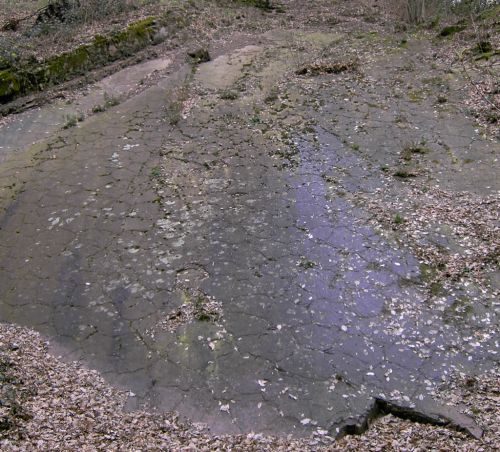 |
Deutsche Version (English version below): |
An
obiger Koordinate findest du ein sehenswertes Naturdenkmal in
Altenberg. Dabei handelt es sich um einen devonischen Meeresboden,
der ca. 360 Mio. Jahre alt ist. Schaut man sich diesen genauer an,
so findet man dort Rippelmarken, wie sie auch bei Rippelmarken Eifgenburg zu finden sind
{Rippelmarken sind von einem fließenden Medium (Flüssigkeit, Gas =
Fluid) hervorgerufene annähernd parallele Strukturen an der
Grenzfläche zu einem feinkörnigen Sediment wie einem Silt oder
Sand). Neben den Rippelmarken erkennt man zudem merkwürdige
polygonartige Strukturen. Hierbei handelt es sich um fossile
Trockenrisse, wie man sie auch heute am Boden ausgetrockneter
Tümpel beobachten kann. Die Trockenrisse sind Teil eines ehemaligen
Wattboden, der trocken fiel. Die Rippelmarken hatte zuvor das
ablaufende Wasser hinterlassen. Als die nächste Flut auflief,
füllten sich die netzartigen Trockenrisse mit sandig-tonigem
Sediment.

Fossiles Wattenmeer
Um
diesen Earthcache zu loggen, erfülle bitte folgende
Aufgaben:
- Schau dir die Oberfläche genau an und beschreibe mir in einer
Mail die Ausrichtung / der Verlauf der
Rippelmarken!
- Mache bitte freiwillig ein Foto von dir vor dem Wattenmeer
an obiger Koordinate. Falls du alleine bist, reicht auch ein Foto
von deinem GPS mit lesbaren Koordinaten.
 |
English version: |
At
the above coordinates you find a fossil tideland, which is over 360
million years old. If you look at the tideland more carefully you
will see ripple marks, which can also be found at Rippelmarken Eifgenburg (ripple marks are
sedimentary structures that indicate agitation by wind or waves).
In addition to the ripple marks you can see mud cracks. Mud cracks
form within wet clay-rich sediment as it dries and shrinks. They
are readily preserved if they become covered with sediment that
protects them from erosion.

Fossil tideland
To
log this earthcache, perform the following
tasks:
- Look at the tideland carefully and send me an email with a
description of the alignment of the ripple
marks!
- Please take optional a photo of you in front of the
tideland at the above coordinates. If you are there without any
help, you can take a photo of your GPSr with readable coordinates
instead.
